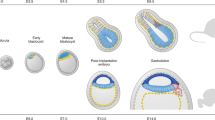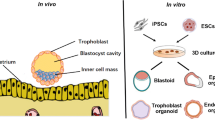Abstract
Embryonic stem cells give rise to teratomas when injected in vivo in experimental animal models. The characterization, the manipulation, and the breaking off of this specific characteristic are doubtlessly the last frontier for the applications of stem cells in translational medicine. Moreover, the urgency to adapt to new scientific demands drives the researcher to find alternative and faster models for testing the teratogenic properties of embryonic stem cells. Here, we compare the emerging model of the chick embryo chorioallantoic membrane (CAM) to the murine model, which represents the gold standard procedure for teratogenesis.
Access this chapter
Tax calculation will be finalised at checkout
Purchases are for personal use only
Similar content being viewed by others
References
Peterson CM, Buckley C, Holley S, et al. (2012) Teratomas: a multimodality review. Curr Probl Diagn Radiol 41: 210–2019. Available from: https://doi.org/10.1067/j.cpradiol.2012.02.001
Vitorovic D, Rosenblum J, Thomas C et al (2012) Primary CNS teratocarcinoma. Front Neurol 3:14
Hammen I, Lal Yadav A (2018) Teratoma as unusual cause of chest pain, hemoptysis and dyspnea in a young patient. Respir Med Case Rep 23:77–79. Available from: https://doi.org/10.1016/j.rmcr.2017.12.006
Aleckovic M, Simón C (2008) Is teratoma formation in stem cell research a characterization tool or a window to developmental biology? Reprod Biomed Online 17:270–280. Available from: https://doi.org/10.1016/S1472-6483(10)60206-4
Blum B, Benvenisty N (2007) Clonal analysis of human embryonic stem cell differentiation into Teratomas. Stem Cells 25:1924–1930
Abdulrazzak H, Moschidou D, Jones G, Guillot PV (2010) Biological characteristics of stem cells from foetal, cord blood and extraembryonic tissues. J R Soc Interface 7:675–676
Onishi K, Zandstra PW (2015) LIF signaling in stem cells and development. Development 142:2230–2236
Graf U, Casanova EA, Cinelli P (2011) The role of the leukemia inhibitory factor (LIF) – pathway in derivation and maintenance of murine pluripotent stem cells. Genes 2:280–297
Blum B, Bar-Nur O, Golan-Lev T et al (2009) The anti-apoptotic gene survivin contributes to teratoma formation by human embryonic stem cells. Nat Biotechnol 27:281–287
Corsini M, Moroni E, Ravelli C et al (2020) In situ DNA/protein interaction assay to visualize transcriptional factor activation. Methods Protoc 3:1–8
Corsini M, Ravelli C, Grillo E, et al (2021) Simultaneously characterization of tumoral angiogenesis and vasculogenesis in stem cell-derived teratomas. Exp Cell Res 400:112490. Available from: https://doi.org/10.1016/j.yexcr.2021.112490
Tian C, Wang Y, Sun L et al (2011) Reprogrammed mouse astrocytes retain a “memory” of tissue origin and possess more tendencies for neuronal differentiation than reprogrammed mouse embryonic fibroblasts. Protein Cell 2:128–140
Acquarone M, De Melo TM, Meireles F et al (2015) Mitomycin-treated undifferentiated embryonic stem cells as a safe and effective therapeutic strategy in a mouse model of Parkinson’s disease. Front Cell Neurosci 9:1–12
Chen KG, Mallon BS, Hamilton RS, et al (2012) Non-colony type monolayer culture of human embryonic stem cells. Stem Cell Res 9: 237–248. Available from: https://doi.org/10.1016/j.scr.2012.06.003
Zhu F, Sun B, Wen Y et al (2014) A modified method for implantation of pluripotent stem cells under the rodent kidney capsule. Stem Cells Dev 23:2119–2125
Nelakanti RV, Kooreman NG, Wu JC (2015) Teratoma formation: a tool for monitoring pluripotency in stem cell research. Curr Protoc Stem Cell Biol 32:4a.8.1–4a.8.17
Haraguchi S, Matsubara Y, Hosoe M (2016) Chick embryos can form teratomas from microinjected mouse embryonic stem cells. Develop Growth Differ 58:194–204
Acknowledgments
This work was supported by grants from Fondazione Italiana per la Ricerca sul Cancro (AIRC) to S.M. (IG 2021 Id 25726) and AIRC Fellowship for Italy 2021 to M.C. (Project Code 26917). In addition, the authors are grateful to Prof. Marco Presta, Prof. Patrizia Dell’Era, and Prof. Roberto Ronca for the scientific discussion.
Author information
Authors and Affiliations
Corresponding author
Editor information
Editors and Affiliations
Rights and permissions
Copyright information
© 2023 The Author(s), under exclusive license to Springer Science+Business Media, LLC, part of Springer Nature
About this protocol
Cite this protocol
Corsini, M., Mitola, S. (2023). Alternative In Vivo Models to Study Teratoma. In: Ribatti, D. (eds) Tumor Angiogenesis Assays. Methods in Molecular Biology, vol 2572. Humana, New York, NY. https://doi.org/10.1007/978-1-0716-2703-7_14
Download citation
DOI: https://doi.org/10.1007/978-1-0716-2703-7_14
Published:
Publisher Name: Humana, New York, NY
Print ISBN: 978-1-0716-2702-0
Online ISBN: 978-1-0716-2703-7
eBook Packages: Springer Protocols




